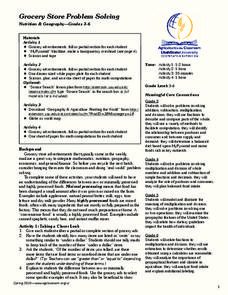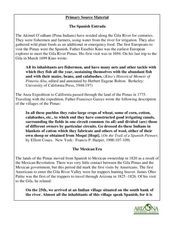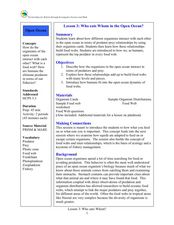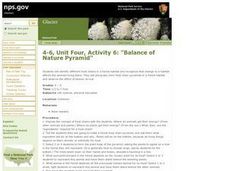Curated OER
Bugs in the Woods
Second graders identify insects and plants in the forest ecosystem in a structured field trip with stations and activity booklets. In this bugs instructional activity, 2nd graders explore the ecosystem of the forest, complete the...
National Park Service
The Secret of Life
Dead trees provide nutrients for the soil, food for animals, protection and a home for organisms, a seed-bed for new trees, and a place for nitrogen-fixing bacteria to live. In the activity, pupils collect decaying logs, expose them to a...
US Environmental Protection Agency
Non-Point Source Pollution
Investigate the different types of pollution that storm drain runoff carries into oceans, lakes, rivers, and streams with this class demonstration. Using an aquarium and an assortment of everyday items that contaminants like motor oil,...
Council for Economic Education
What's the Big Deal about Spices?
Today's gourmands don't consider spices to be the equivalent of silver and gold. During the middle ages, however, these commodities were precious. People back then used spices in religious ceremonies, to cure rotten food, and as a show...
Curated OER
Dietary Guidelines/Food Pyramid Test
Students list the recommended dietary guidelines and explain their function and implementation. They teat their knowledge of the Dietary Guidelines and the Food Guide Pyramid. They evaluate the servings, serving sizes, and food sources...
Curated OER
Exploring Ecology
Students explore the basics of ecology through numerous hands-on and relevant activities. They participate in an online food chain demonstration, which explores food web dynamics. They dissect owl pellets, examine the prey's bones, and...
Arizona Board of Regents
The Pyramid of Power
Students explore the food pyramid, nutrition, and how to plan a balanced diet. This fun activity is well-planned and a great introduction to the food pyramid!
Curated OER
Agriculture in Your Life
Young scholars explore the origins of food and other everyday products around the United States. In this agricultural lesson, students learn basic vocabulary and practice matching common items with their agricultural source. They...
Curated OER
You Are What You Eat (The 6 Main Nutrients Found in Foods)
Pupils study how carbohydrates, proteins, fats, vitamins, minerals and water provide basic nutrients for body growth and function. They describe quality sources of the basic nutrients and the importance of water.
Curated OER
Grocery Store Problem Solving
Students use multiple math skills to complete grocery story problems. In this grocery math lesson plan, students study grocery ads to learn about the cost of foods. Students investigate food types and the costs of processed versus raw...
Curated OER
Diet and Nutrition
Young scholars figure out the nutritional values of foods to explain the nature of a healthy diet by looking at fast food nutrition pamphlets and calculating the values of foods then comparing them to the food pyramid.
Curated OER
My Pyramid
Tenth graders analyze the new Food Guide Pyramid. In this healthy diet lesson, 10th graders explore the the website with the new food pyramid. Students use magazines to find foods from the food groups and create their own pyramid....
Curated OER
Key to Good Health #1: Nutrition
Students learn tips for healthy eating. In this nutrition lesson plan, students learn about the four main food groups, view a food pyramid, and get tips on how to get the most nutrition out of their meals. Students also learning about...
Curated OER
The Spanish Entrada
In this Arizona history worksheet, high schoolers read a 5 page selection that includes primary sources about time periods in the state's history. Students then respond to 5 short answer questions based on the selection.
Curated OER
Rice Nutrition
Third graders investigate nutrition by researching rice. For this food lesson, 3rd graders read about the healthy aspects of rice and how many people in the world eat it. Students read nutrition labels and discuss the different energy...
Curated OER
Who Eats Whom in the Open Ocean?
Students examine how organisms interact with one another in the ocean. In this science lesson, students discuss predators and prey in the ocean. Students discuss food webs and how organisms interact with each other.
Curated OER
Balance of Nature Pyramid
Students study the concept of food chains and create a physical forest food chain pyramid. In this balance of nature pyramid instructional activity, students identify the ingredients needed on each level of the pyramid then make...
Curated OER
Regulation and handling of animal products: a special challenge
Students examine how food safety affects sustainable animal production and marketing. In this agriculture lesson students complete several activities including one on groceries and the rules of animal products.
Curated OER
Rice is Nice
First graders explore Japanese foods through fairy tales, fiction and nonfiction books, cooking meals and eating with chopsticks. After all of the creative ideas have been utilized, the class holds a tea party for parents in the classroom.
Curated OER
Grains, Fats, and Sugars in Healthy Proportions - Skill
Students investigate dietary guidelines and the food guide pyramid. They prepare various versions of pasta and muffins, and compare the taste, calories, fat, and cholesterol content.
Curated OER
Energy and the Environment
Fifth graders define alternative energy form, design models which show how the energy source can be used, and explain the purpose of dams.
Curated OER
Discovering New Species
Students identify animals observed by Lewis and Clark while evaluating the animal's habitat and describing the animal's behavior. Students construct a food web mobile to illustrate the animal's position in the food web in the 19th...
Curated OER
Habitat survival
Sixth graders study different environments and how the food chain affects the survival of different animals. In this environments lesson plan, 6th graders share the visuals which describe the characteristics of the environment that they...
Curated OER
Charting Mold Growth
Students chart mold growth based on food supply. For this mold growth lesson plan, students chart micro-organism growth and the decline of the growth as food runs out.

























